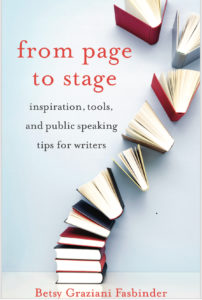6 things every author can do to captivate an event audience
Today’s guest blogger, Betsy Graziani Fasbinder, is an award-winning novelist, memoirist, and public speaking coach. She shares her coaching expertise in her new book, From Page to Stage: Inspiration, Tools, and Public Speaking Tips for Writers, published just this week. Watch this space in coming weeks for my book review. Learn more about Betsy on her website.
6 things every author can do to captivate an event audience
By Betsy Graziani Fasbinder
Speaking in public is one of the best ways to give our books and ideas their biggest chance of success.
Whether your agenda for any single event is to celebrate, inspire, educate, or entertain, captivating your listeners is your method for achieving it.
If this sounds familiar, it should. Isn’t that the goal of every book or story you write? You want to gain the attention of readers from page one, and keep it for the duration of the story, giving them a satisfying experience, and leaving them wishing for more pages from you. You want to pull them out of their world and into yours.
That’s exactly what a dynamic, engaging author talk should do.
But how?
How can authors captivate their listeners during book launches, subject matter presentations, podcasts, media interviews, and one-on-one conversations?
The following six elements are essential if you want to capture and cultivate the attention of listeners.
1. Think of your talk as a conversation, not a performance.
Much of the “stage fright” I’ve encountered about public speaking arises from the feeling that to speak in public is to give a performance that feels unnatural.
If you change your mindset to think of your talk as a conversation—even an intimate conversation—rather than a stage performance, you’re tapping into a skill you use every day, and one at which you’re likely highly skilled in.
The best talks I’ve delivered, and the best ones I’ve seen, are not soaring oratory; they are intimate, vulnerable, candid, natural conversations. Sometimes this means that there is a literal conversation, where audience members ask questions or voice their ideas. But a talk can be a conversation even when the audience is silent.
2. Shrink your audience down to one.
A mental shift that makes a huge difference in engaging your listeners is thinking of your talk not only as a conversation, but as a series of one-on-one conversations with each person in your audience.
During an in-person presentation, whether you have five or 500 listeners, if you try to talk to all of them at once, with your eyes scanning and darting over the crowd, you’ll make no intimate connections at all. In fact, you can appear panicky, or worse, dishonest. (Think of what the term “shifty-eyed” means.)
Instead, focus your eye contact and linger on one person at a time, for just a few seconds each. Make a visual connection. Then, move your eyes to another listener. Do this in a random, unpredictable pattern.
If this sounds odd, observe how you might tell a story to guests at a large table during a dinner party. It’s the most natural way. Eye contact helps listeners feel included and engaged.
3. Use your storytelling skills.
Why do writers so often forget their storytelling skills when they speak in public?
The trick is to remember to use conflict, point of view, metaphor, suspense, and other devices in your spoken word as you do in your written pieces.
If you think of your presentation as a story, rather than as a speech, you’ll feel more natural and in your element. Sure, you can convey information, but do so through compelling storytelling, vivid sensory details, and all of the tools that you know to hook readers and keep them hooked.
4. Choose to be “present” rather than “perfect.”
Writers (like lots of folks) often dislike public speaking; some find the mere idea of it horrifying. My theory is that writers are used to having the opportunity to polish their prose before others read their work. When we speak, there’s no edit function, no cut-and-paste, no find-and-replace so that we can instantly rearrange our words.
Many writers I’ve worked with get so wrapped up in trying to make their spoken words perfect that they forget to be present. Being “present” is the idea of being wholly in the moment with your listeners in a spontaneous and natural way.
If you’re “present,” connected with listeners through eye contact and storytelling, and not stiffly delivering a perfectly memorized talk, they’ll forgive imperfections. They’ll likely not notice the small errors that we all inevitably make, and they’ll even forgive bigger errors if you have a bit of grace and a sense of humor about them.
Your natural, authentic presence captivates an audience far more than any perfectly delivered content ever will.
5. Say less and be remembered more.
 Whether it’s nervous chatter, lack of preparation, or simply trying to pack too much information into too little time, lots of speakers say way too much at their events. They speak in rapid-fire and barely breathe between thoughts.
Whether it’s nervous chatter, lack of preparation, or simply trying to pack too much information into too little time, lots of speakers say way too much at their events. They speak in rapid-fire and barely breathe between thoughts.
Embrace silence as an important element of your talk.
Silence in a spoken story is like the white space and punctuation we use in our written stories. Without the spaces, the story stops being a story and instead is just a bunch of words.
Shorten your sentences. Let silence linger after you’ve spoken an important, emotional, or even funny idea so that it can soak in and your listeners can visualize what you’re saying.
I always suggest that a speaker should prepare content for no more than about two-thirds of the time they’re given. For a 30-minute talk, prepare only 20 minutes of content. Time yourself as you practice so you know how long it will take.
By not over-packing, and using silence as part of your talk, your listeners are far more likely to absorb and retain what you say. They will walk away feeling more connected to you and your ideas.
6. Let your heart show.
When I go to author events, or listen to an author interview on the radio or a podcast, it’s because I want to know the story behind the story. I love learning about the original inspiration for a book or the horrible working title that preceded the final one.
Everyone loves gaining a special connection with authors they love and learning little secrets that make the book that much more fascinating. Let your listeners know and connect to the person behind the pages.
It’s not easy
 Engaging and captivating listeners is no small task.
Engaging and captivating listeners is no small task.
Because writers already know the importance of doing this in their written work, they’re at a huge advantage if they use their skills during spoken presentations.
By having an intimate, candid conversation with listeners, letting them in on a bit of who you are, and being “present” during your talks, you’ll engage their hearts and imaginations. You’ll captivate audience members who become readers, fans, and super fans.
Like what you’re reading? Get it delivered to your inbox every week by subscribing to the free Build Book Buzz newsletter. You’ll also get my free “Top 5 Free Book Promotion Resources” cheat sheet immediately!



Fantastic tips! Every author would benefit by reading this.
I’m so happy you like Betsy’s advice, Mimi! Please feel free to share the link to the post with your author network so Betsy reaches more people with her wisdom.
Sandy
All good tips. For some reason, the minute I was published, I had absolutely no trouble speaking to crowds as big as 500 people. One trick I learned from a “pro” was to keep an imaginary basketball in your hands. When you make a point, use your hands to “throw” the basketball outwards, opening your hands in the process, and then receive the basketball back. I’ve seen speakers do this who don’t even know the basic concept–they do it naturally. It gives you something to do with your hands and makes you look and feel interactive with the audience.
Thanks for that excellent tip, Terry! I’m going to watch professional speakers more closely now to see if I can identify this.
Sandy
Sandy, Love these tips, especially #2. Thanks for keeping us up to speed with what works.
Great tips! Thanks for sharing. Do you have an tips about WHAT part of a story to share/read in book launches or readings? I’d appreciate that tidbit of info!
Hi Sandy. I think it’s often less important which part of a story to read (other than spoilers, of course) than it is that we select a piece that gives the flavor of the story, engages on an emotional level, and piques the liteners’ curiosity leaving them wanting more. If this can be the first pages of the book, that’s great. But if your selection comes a bit later in the story and requires very little set-up, but tees up the premise of the story in an intriguing way, that can work as well. Also, a taste is better than a banquet. Readings that are on the shorter side are easier for keeping the attention from a read-aloud audience.
Great article! I love public speaking but I can always learn more tricks. The idea is to captivate my audience, for sure!
Thanks for the tips. I´m a Portuguese writer of novels and short stories .
Hoping to hearing from you 🙂
What would you like to hear about?
Sandy